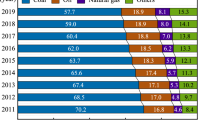Thermal flow-reversal oxidation is the main technology that can effectively reduce emissions of ventilation air methane. As the core component of coal mine ventilation oxidation devices, honeycomb ceramic oxidation beds play a decisive role in the functionality of these devices. The thermal fatigue properties of mullite ceramic, which is commonly used in oxidation beds, were tested in the present research. Then, the service life of the oxidation bed was predicted according to the intensity attenuation law and the thermal fatigue experimental data. The results of the fatigue experiment indicated that in general, the bending strength of mullite ceramics decreases as thermal shocks increase. At higher temperature differences, the bending strength decreased at higher rates. At the temperature differences between 600 and 800°C, the bending strength initially declined. Then, after reaching a certain value, it remained unchanged for a while before declining again. The calculation results via the proposed equation based on the intensity attenuation theory and the thermal fatigue experimental data indicate that the thermal fatigue life of an oxidation bed is about 1–8 months. The predicted result is consistent with actual working conditions.






Similar content being viewed by others
References
Y. P. Cheng, L. Wang, and X. L. Zhang, “Environmental impact of coal mine methane emissions and responding strategies in China,” Int. J. Greenhouse Gas Control, 5, 157–166 (2011).
K. Warmuzinski, “Harnessing methane emissions from coal mining,” Process Safety Environ. Protect., 86, 315–320 (2008).
K. Gosiewski, Y. Sh. Matros, K. Warmuzinski, et al., “Homogeneous vs. catalytic combustion of lean methane-air mixtures in reverse-flow reactors,” Chem. Eng. Sci., 63, 5010–5019 (2008).
Y. X. Yuan, “Emission and utilization of coal mine VAM,” Energy and Energy Conservation, 11, 55–57 (2012).
I. Karakurt, G. Aydin, and K. Aydiner, “Mine ventilation air methane as a sustainable energy source,” Renewable and Sustainable Energy Reviews, 1, 1042–1049 (2011).
P. F. Wang, T. Feng, and X. L. Hao, “One-dimensional numerical simulation of thermal reverse-flow oxidation of ventilation air methane in coal mine,” J. Min. Safety Eng., 29, 435–439 (2012).
M. M. Mao, Y. Q. Liu, B. Zheng, et al., “Investigation of temperature distribution uniformity in a preheating catalytic oxidation bed,” J. China Coal Soc., 40, 109–114 (2015).
P. Y. Sang, L. Chen, X. N. Zhang, et al., “Mine diluted gas low concentration gas oxidation numerical simulation research,” Coal Chem. Industry, 37, 24–27 (2014).
P. F. Wang, T. Feng, S. L. Li, et al., “Resistance characteristics of thermal reverse flow oxidation bed for coal mine ventilation air methane,” Natural Gas Industry, 32, 73–77 (2012).
Z. Z. **, Y. W. Bao, and X. M. Yue, “High temperature fatigue strength degradation theory for structural ceramics,” High Technol. Lett., 12, 31–36 (1994).
J. Z. Wang, Z. Z. **, H. Wang, et al., “Research on thermal shock fatigue of refractories,” J. Chinese Ceram. Soc., 28, 91–94 (2000).
Z. X. Li, X. S. Wang, and Z. G. Wang, “Analysis on the devastate mechanics of ceramic regenerative materials,” Metallurgy and Energy, 22, 43–45 (2003).
Acknowledgments
This work is supported by the grant from the National High Technology Research and Development Program of China (863 Program) (2009AA063202) and the Shandong Province Natural Science Fund (ZR2013EEQ008, ZR2011EL017).
Author information
Authors and Affiliations
Corresponding author
Additional information
Translated from Problemy Prochnosti, No. 1, pp. 13 – 19, January – February, 2016.
Rights and permissions
About this article
Cite this article
Liu, Y.Q., Shang, Q.H., Zhang, D.H. et al. Thermal Fatigue Life Prediction of Ventilation Air Methane Oxidation Bed. Strength Mater 48, 8–13 (2016). https://doi.org/10.1007/s11223-016-9731-x
Received:
Published:
Issue Date:
DOI: https://doi.org/10.1007/s11223-016-9731-x




